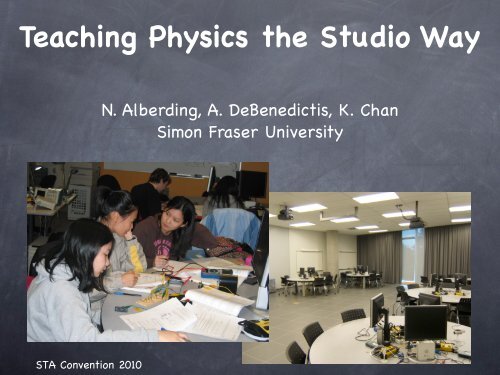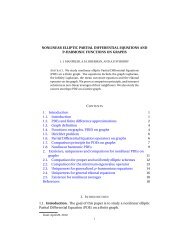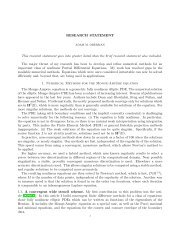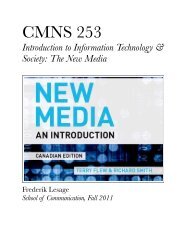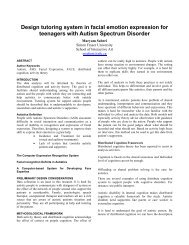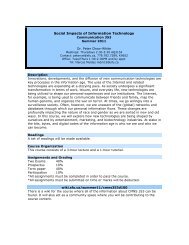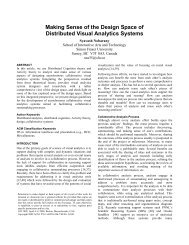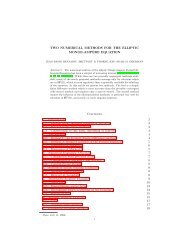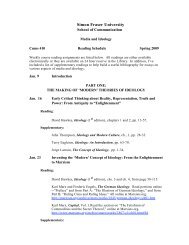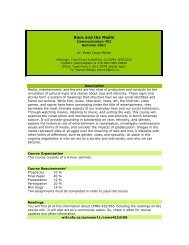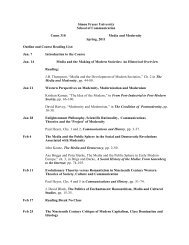Teaching Physics the Studio Way - SFU Wiki - Simon Fraser University
Teaching Physics the Studio Way - SFU Wiki - Simon Fraser University
Teaching Physics the Studio Way - SFU Wiki - Simon Fraser University
You also want an ePaper? Increase the reach of your titles
YUMPU automatically turns print PDFs into web optimized ePapers that Google loves.
<strong>Teaching</strong> <strong>Physics</strong> <strong>the</strong> <strong>Studio</strong> <strong>Way</strong><br />
N. Alberding, A. DeBenedictis, K. Chan<br />
<strong>Simon</strong> <strong>Fraser</strong> <strong>University</strong><br />
STA Convention 2010
An introduction to a Workshop-format first year<br />
physics course at a large Canadian university.<br />
What is Workshop <strong>Physics</strong><br />
How we got started.<br />
Curriculum.<br />
Facilities and Equipment.<br />
Initial <strong>SFU</strong> Results.<br />
STA Convention 2010
What is Workshop <strong>Physics</strong><br />
Developed by Priscilla Laws at Dickinson College in<br />
1987, in collaboration with David Sokoloff, U of<br />
Oregon, and Ronald Thornton, Tufts <strong>University</strong><br />
Replace traditional lectures with learning by<br />
inquiry<br />
Method: examination of preconceptions, qualitative<br />
observations, reflection and discussion,<br />
development of definitions and ma<strong>the</strong>matical<br />
<strong>the</strong>ories, quantitative experimentation<br />
http://physics.dickinson.edu/~wp_web/wp_homepage.html
h =<br />
Workshop <strong>Physics</strong> Results<br />
gain<br />
possible gain<br />
=<br />
post average % − pre average %<br />
100 − pre average %<br />
Gaussian fit to histogram of FCI gains in traditional,<br />
tutorial, and WP classes at 8 institutions.
A new <strong>Simon</strong> <strong>Fraser</strong> <strong>University</strong> campus<br />
in Surrey provided an opportunity to<br />
try a new approach to <strong>the</strong> curriculum.<br />
<strong>Studio</strong> <strong>Physics</strong> was<br />
“sold“ to <strong>the</strong> <strong>SFU</strong><br />
Surrey planners as a<br />
cutting-edge new<br />
curriculum and so a<br />
great recruiting tool<br />
for <strong>the</strong> new campus.<br />
STA Convention 2010<br />
<strong>SFU</strong> Surrey Campus
Curriculum<br />
Based on Workshop <strong>Physics</strong> I&II by Laws etal<br />
<strong>Physics</strong> 140 (4 credits)<br />
•! Computerized data<br />
acquisition and analysis<br />
•! Forces, Mass and Motion<br />
•! Gravity<br />
•! Projectile motion<br />
•! Collisions<br />
•! Energy<br />
•! Rotational Motion<br />
•! Oscillations<br />
•! Relativity*<br />
<strong>Physics</strong> 141 (4 credits)<br />
•! Electric Fields and<br />
Potentials<br />
•! DC Electric Circuits<br />
•! AC Circuits*, Capacitors<br />
•! Magnetism<br />
•! Optics, Lenses & Mirrors*<br />
•! Diffraction*<br />
•! Quantum <strong>Physics</strong>*<br />
•! Formal Written Report<br />
• Lab Practical Exam<br />
<strong>Physics</strong> 140 & 141 are eqivalent to two 3-credit lecture courses<br />
(PHYS 120 and 121) and one 2-credit laboratory course (PHYS 131).<br />
* Activity Guides for <strong>the</strong>se topics developed at <strong>SFU</strong>.<br />
STA Convention 2010
Typical Class<br />
( Three 110 minute classes per week.)<br />
Introduction, questions and<br />
daily organization (5-10 min)<br />
Mini-lecture (15 min)*<br />
Hands-on small group activities<br />
following “Activity Guide”<br />
handouts (60-80 min)<br />
Large Group Activity or Demo<br />
(20 min)<br />
Wrap-up Discussion (5-10 min)<br />
* Very occasionally a longer lecture (up to 50 min)<br />
STA Convention 2010
Page 1-1 Workshop <strong>Physics</strong> Activity Guide <strong>SFU</strong> 1067<br />
Collecting Data on Pitching Speeds<br />
In order to measure your pitching speed, you'll need:<br />
• A timer (accurate to 1/100th of a second)<br />
• A mitt (or a slow partner or an iron hand)<br />
• A baseball (or o<strong>the</strong>r ball in case of bad wea<strong>the</strong>r).<br />
In this activity, you should use a pre-measured<br />
series of distances. You should work with a<br />
partner and each of you should pitch a baseball<br />
three times at a comfortable distance. The o<strong>the</strong>r<br />
partner can time <strong>the</strong> flight of <strong>the</strong> baseball. (To<br />
save time, you may co-operate with ano<strong>the</strong>r<br />
group of students.) Some of you pros might want<br />
to try pitching from a full 20 metre distance,<br />
which is longer than <strong>the</strong> standard 18.4 metre<br />
distance used in <strong>the</strong> major leagues. Please warm<br />
up a bit. Don't kill your arm!<br />
! Activity 1-2: Pitching Speed Data (groups of 3)<br />
(a) Fill in <strong>the</strong> data table in <strong>the</strong> space below for yourself and two o<strong>the</strong>r<br />
classmates and calculate <strong>the</strong> average time and speed for each person to<br />
two decimal places.<br />
(b) Calculate <strong>the</strong> average speed in kilometres per hour you measured for<br />
your own pitch . Show all <strong>the</strong> steps in your calculation. How good was<br />
your prediction!<br />
Name<br />
Distance<br />
(m)<br />
t1<br />
(s)<br />
t2<br />
(s)<br />
t2<br />
(s)<br />
Average t<br />
(s)<br />
Average<br />
Speed<br />
(m/s)
1500 sq ft room<br />
6 7-ft diameter<br />
round tables which<br />
seat nine<br />
Dual projectors<br />
Adjacent prep room<br />
Centre aisle for<br />
motion experiments<br />
Facilities and Equipment<br />
multiple<br />
whiteboards<br />
<strong>Physics</strong> <strong>Studio</strong> Room<br />
STA Convention 2010
Individual Stations<br />
One Individual Station<br />
Students work in<br />
groups of three at<br />
each station.<br />
Mac Mini computer,<br />
flat screen display,<br />
Vernier LabPro<br />
interface, various<br />
LabPro probes, iSight<br />
camera, etc...<br />
$7000/Station<br />
STA Convention 2010
Force Activity<br />
<strong>Physics</strong> <strong>Studio</strong><br />
STA Convention 2010
Initial Results<br />
Force Concept Inventory (FCI) Exam Scores 2007 (out of 30):<br />
Workshop Format PHYS 140 Pre-test: 18.4 Post: 22.9 Gain: 0.40<br />
Lecture Format PHYS 120 Pre-test: 18.2 Post: 20.7 Gain: 0.21<br />
Retention Rates (Final Grade > D)<br />
Fall 08 Fall 07 Fall 06<br />
PHYS 140 86% 79% 76%<br />
PHYS 120 78% 71% 72%<br />
STA Convention 2010
Student Evaluations - Typical Positive Comments:<br />
“I really appreciate <strong>the</strong> studio method as opposed to just<br />
aceppting(sic) a formula as it comes, it really helps to enhance<br />
<strong>the</strong> physics learning experience by learning experimentally where<br />
formulas come from and how to derive <strong>the</strong>m.”<br />
“<strong>the</strong> fact that we can discuss each o<strong>the</strong>r about <strong>the</strong> subjects that<br />
we are learning everyday is a lot better in learning than o<strong>the</strong>r<br />
classes where we just sit and listen to <strong>the</strong> lecture.”<br />
“please and please, keep <strong>the</strong> way it is right now. i liked it very<br />
much.”<br />
STA Convention 2010
Student Evaluations - Typical Negative Comments:<br />
“If I had a choice, I think I would have chosen <strong>the</strong> standard<br />
lecture method over <strong>the</strong> studio method. I find it easier to<br />
understand a particular concept if I had someone explaining it<br />
ra<strong>the</strong>r than reading <strong>the</strong> textbook which I found confusing.”<br />
"Of course, I can’t say from experiance(sic) o<strong>the</strong>r than for o<strong>the</strong>r<br />
courses. I found <strong>the</strong> studio method to rely TOO much on <strong>the</strong><br />
student learning things by <strong>the</strong>mselves, and using it, even though<br />
it may very well be incorrect. The activity guides were not a<br />
resouce(sic) i considered valuable, because it consists of my own<br />
derivations and work, that may not be fully sound.”<br />
“A few more lectures on concepts that are totally new would<br />
make <strong>the</strong> material easier to learn.”<br />
STA Convention 2010
Thank You<br />
http://wiki.sfu.ca/public/index.php/<strong>Studio</strong>_<strong>Physics</strong>


